RAF Gan 1958 and Later
WT Thanks for this thread,very enjoyable.I joined the RAF in '78 and wondered whether I'd ever get to any of the places I used to hear about from the older hands;Masirah Changi,Tengah, Gan etc. Well,I flew Victors and VC10 tankers so I did get to Salalah,Paya Lebar and Diego Garcia so that was fairly close.
The link below is to a film which I know all on here will find fascinating,it's on Live leak so won't be as well known perhaps as something on Youtube.It's called True Bearing about the RAF in the far east.
http://www.liveleak.com/view?i=896_1325197737
The link below is to a film which I know all on here will find fascinating,it's on Live leak so won't be as well known perhaps as something on Youtube.It's called True Bearing about the RAF in the far east.
http://www.liveleak.com/view?i=896_1325197737
Thread Starter
Farefield
Thanks for the link - fascinating.
I recognise many of the locations shown and they bring back memories, especially as during my time in the Far East (1956 - 1958) I served at Changi, Katunayake (Negombo), China Bay, Seletar and Gan and later at the time the film was made (1961), with 99 Sqn whose Brits are featured in the film.
I see from the credits it's a COI Film made in 1961 for the Air Ministry, but it's the first time I've seen it.
Thanks again.
WT
Thanks for the link - fascinating.
I recognise many of the locations shown and they bring back memories, especially as during my time in the Far East (1956 - 1958) I served at Changi, Katunayake (Negombo), China Bay, Seletar and Gan and later at the time the film was made (1961), with 99 Sqn whose Brits are featured in the film.
I see from the credits it's a COI Film made in 1961 for the Air Ministry, but it's the first time I've seen it.
Thanks again.
WT
My abiding memory of Gan is, after climbing out of a hot sweaty Vulcan (1967), watching the SAR Shack crew disembark. All were dressed in shorts/swimming trunks and flip-flops. Best equipped crewmembers wore T-shirts!
Join Date: Jan 2002
Location: Fairford, Glos
Age: 99
Posts: 155
Likes: 0
Received 0 Likes
on
0 Posts
Gan 'Live Leak'
Thanks farefield, some great nostalgia there especially those lovely airborne cine clips of the Britannia, though the stilted R/T was a bit toe-curling as was most of the rest of the dialogue - probably by professional actors, speaking as directed by some MOD official.
The shot of airmen nonchalantly strolling about on a Beverley tailplane obviously pre-dates 'elf 'n safety!
The shot of airmen nonchalantly strolling about on a Beverley tailplane obviously pre-dates 'elf 'n safety!
I can asure you 12 hour sortie in trunks and flip flops was very uncomfortable. We left our kit in the aircraft in case of a scramble, which happened fairly regularly, so we could 'converge' on the aircrraft from any point on the island so as to make our 20 minutes. Invariably as the 'baby co' my flying kit was lost on one scramble, but funnily enough found just after landing.
FEAF Video
Thanks farefield for posting that FEAF video - it brought back many memories

Join Date: Mar 2010
Location: Often in Jersey, but mainly in the past.
Age: 79
Posts: 7,812
Received 137 Likes
on
64 Posts
Excellent, farefield ... thanks for that. Much nostalgia!
Not very strong on runway marking, I note, and the poor old Shack looks a bit battered! Tower r/t patter a bit dated ... it later became "c/c, Your True Bearing is 080 True, I say again 080 True." Relating the numbers made sense!
Not very strong on runway marking, I note, and the poor old Shack looks a bit battered! Tower r/t patter a bit dated ... it later became "c/c, Your True Bearing is 080 True, I say again 080 True." Relating the numbers made sense!

Thread Starter
RAF Gan 1958 - Continued - Part 11
Maldive Islanders
I took these photos mainly on the island of Fedu. Given that these photographs were taken 58-years ago in 1958 and the children shown were then aged about six to nine years old, if they are still around they’ll be aged about sixty plus-years old now.
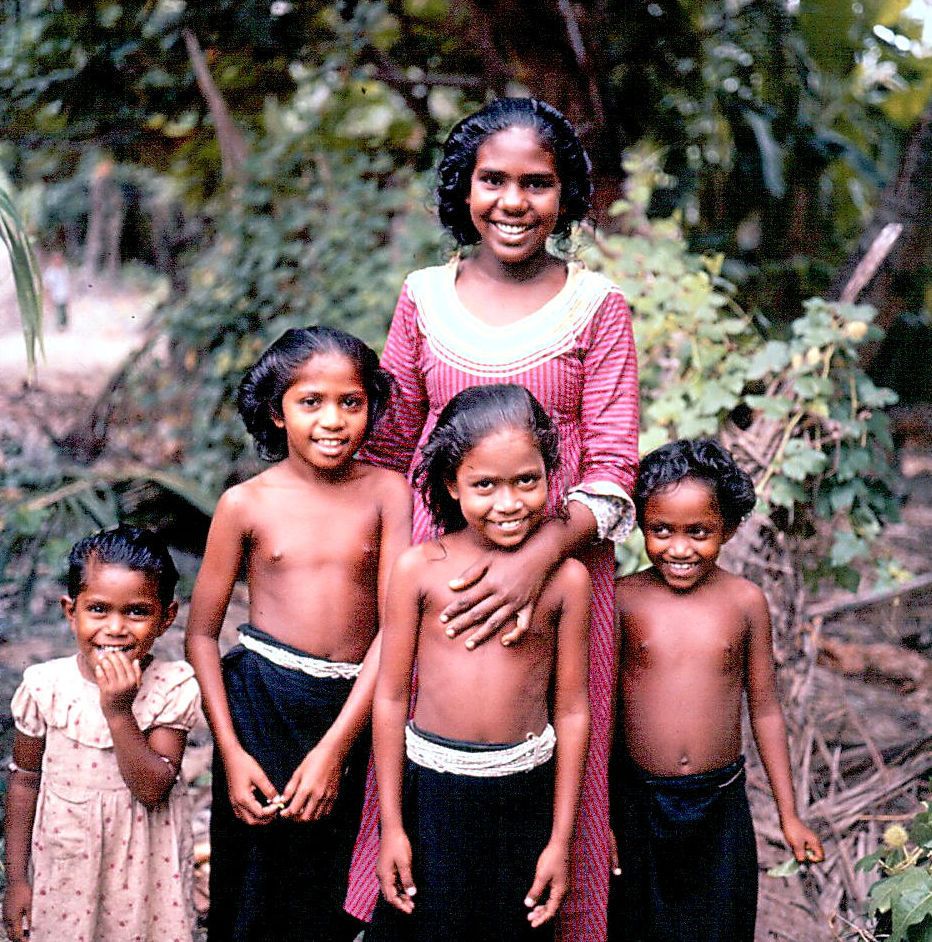

When Britain obtained permission in 1956 to re-establish its wartime airfield on Gan, it was agreed that islanders living on Gan would be resettled on the nearest island, Fedu, with some of the islanders from Fedu moved to the next island, Maradu, where they formed a new village.
As a result the only Maldive islanders we RAF servicemen came into regular contact with in 1958 were the few who worked at Gan. On visits to other islands, mainly Fedu, families with kids would be seen, but that was about all. So my photos of islander’s families were taken on Fedu and Hittadu.
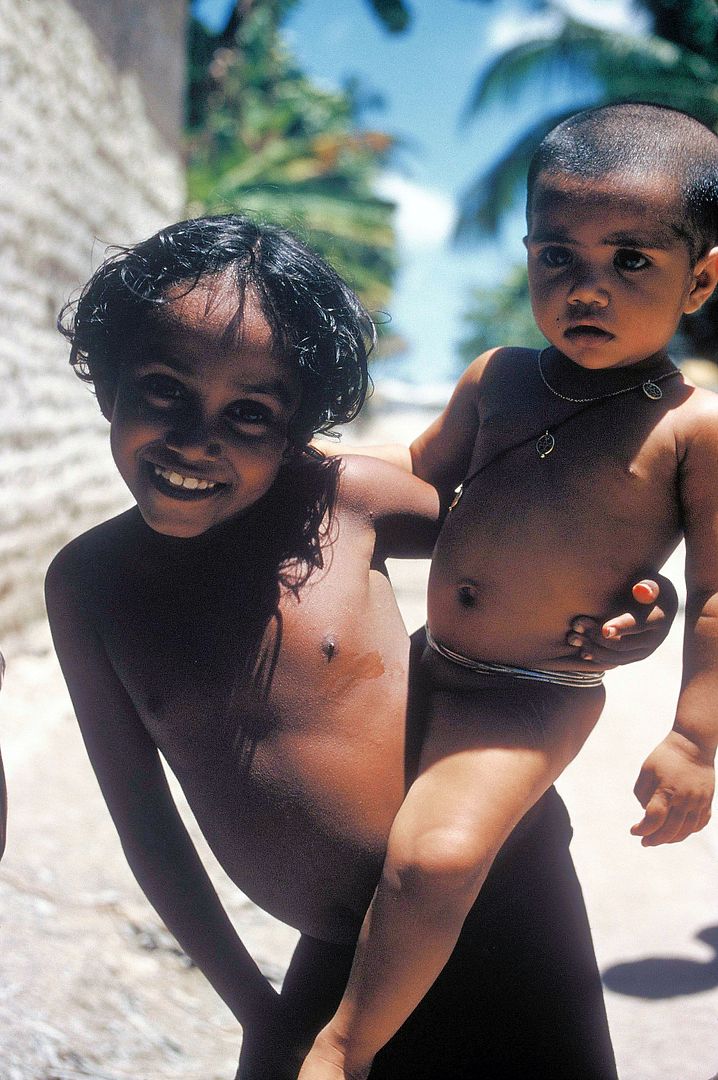
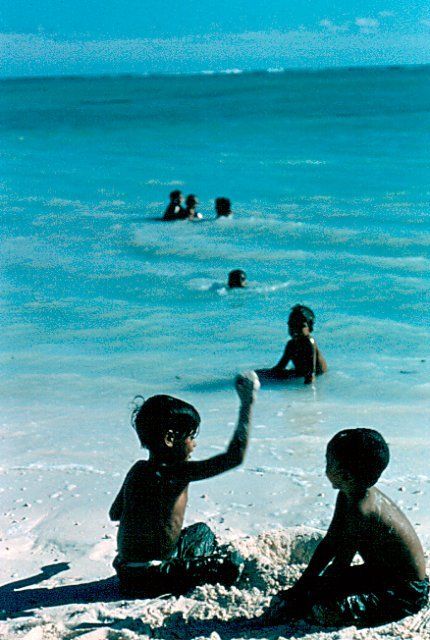
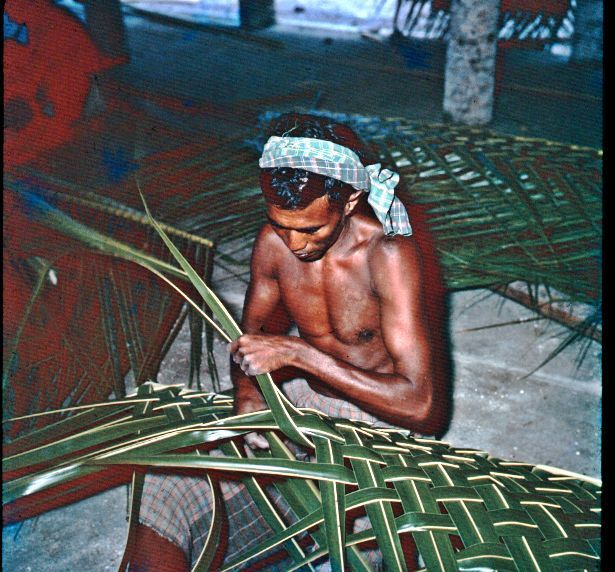
Kadjan (Palm Leaf) Weaving
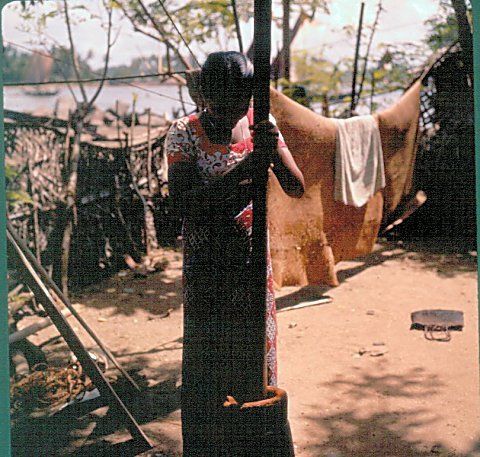
Women using a pestle and mortar to crush Taro. Taro is a tuber that was cultivated extensively on Fedu up to WWII, but declined afterwards with growth confined to people’s gardens.
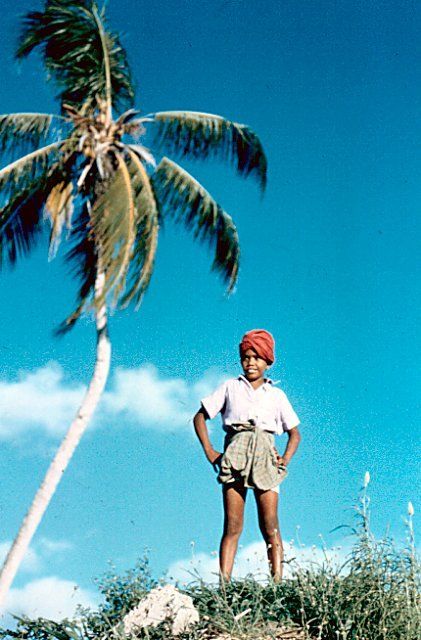
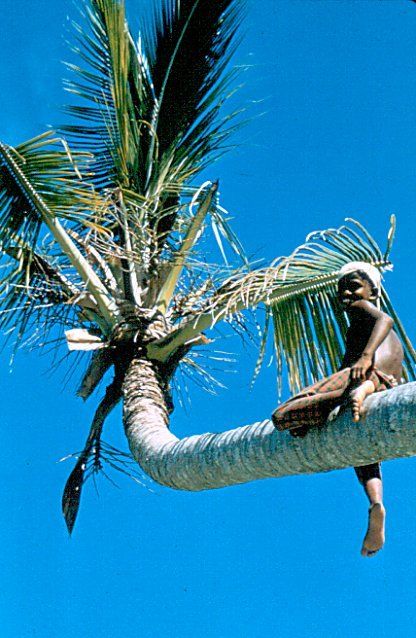
Coconut Collector
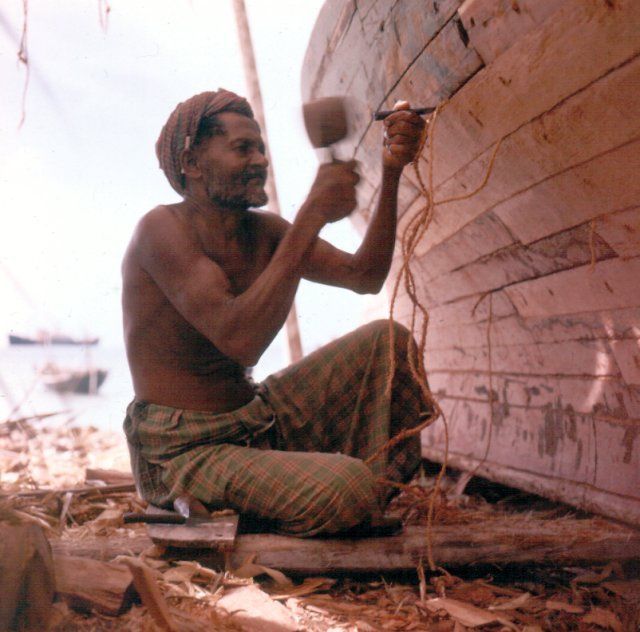
Caulking a Dhoni on Hittadu
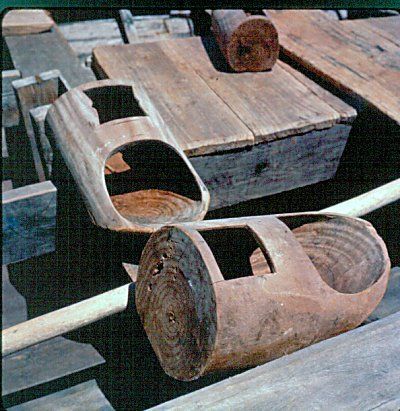
With no ship's chandlers for hundreds of miles, the Islanders were adept at using local materials for essential boating artefacts. Here - chop down a tree, hollow out the trunk and bingo! one has an efficient bailer.
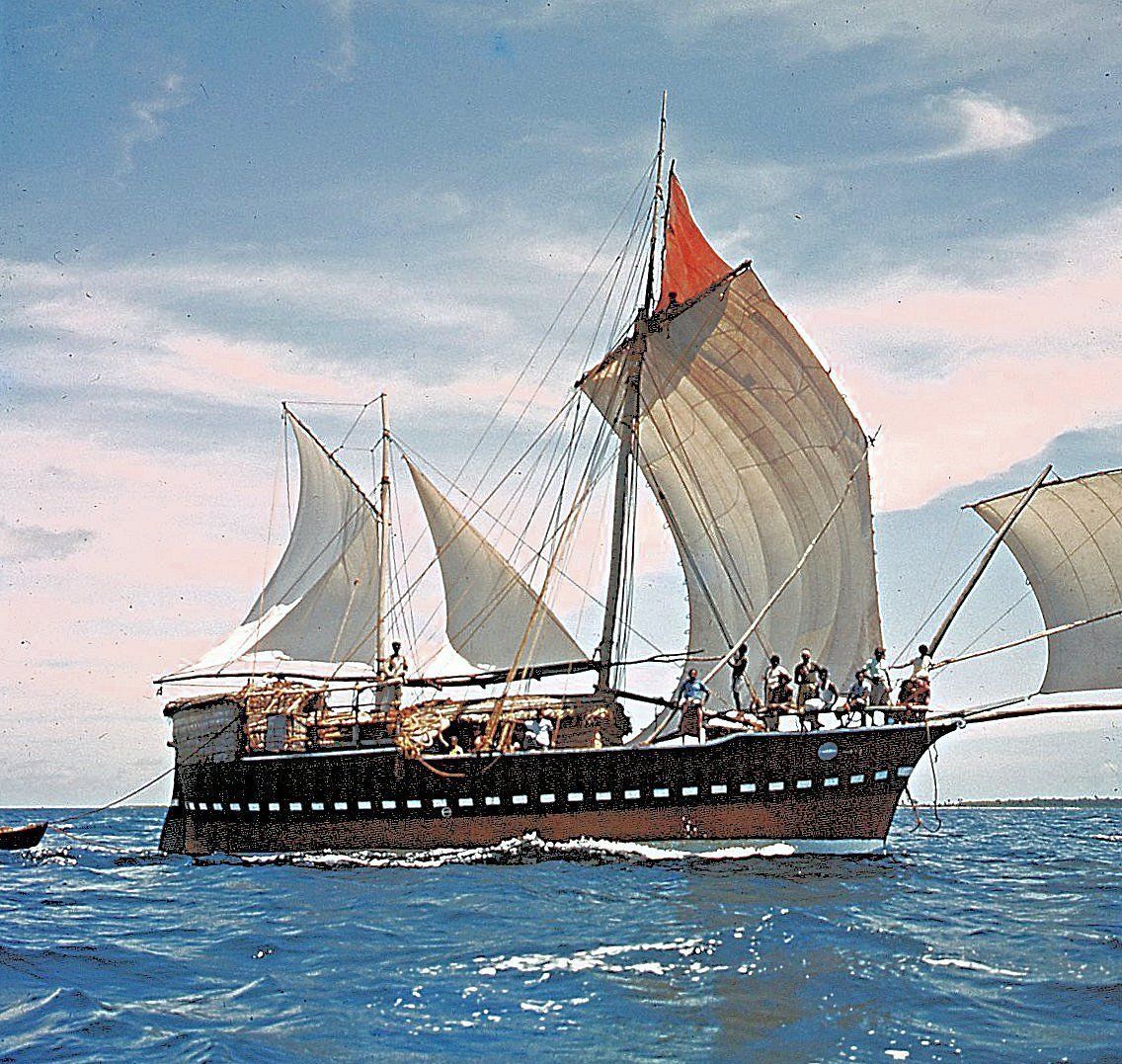
One of the more unusual vessels I photographed was this "Bigaloo". Used for longer inter-atoll journeys.
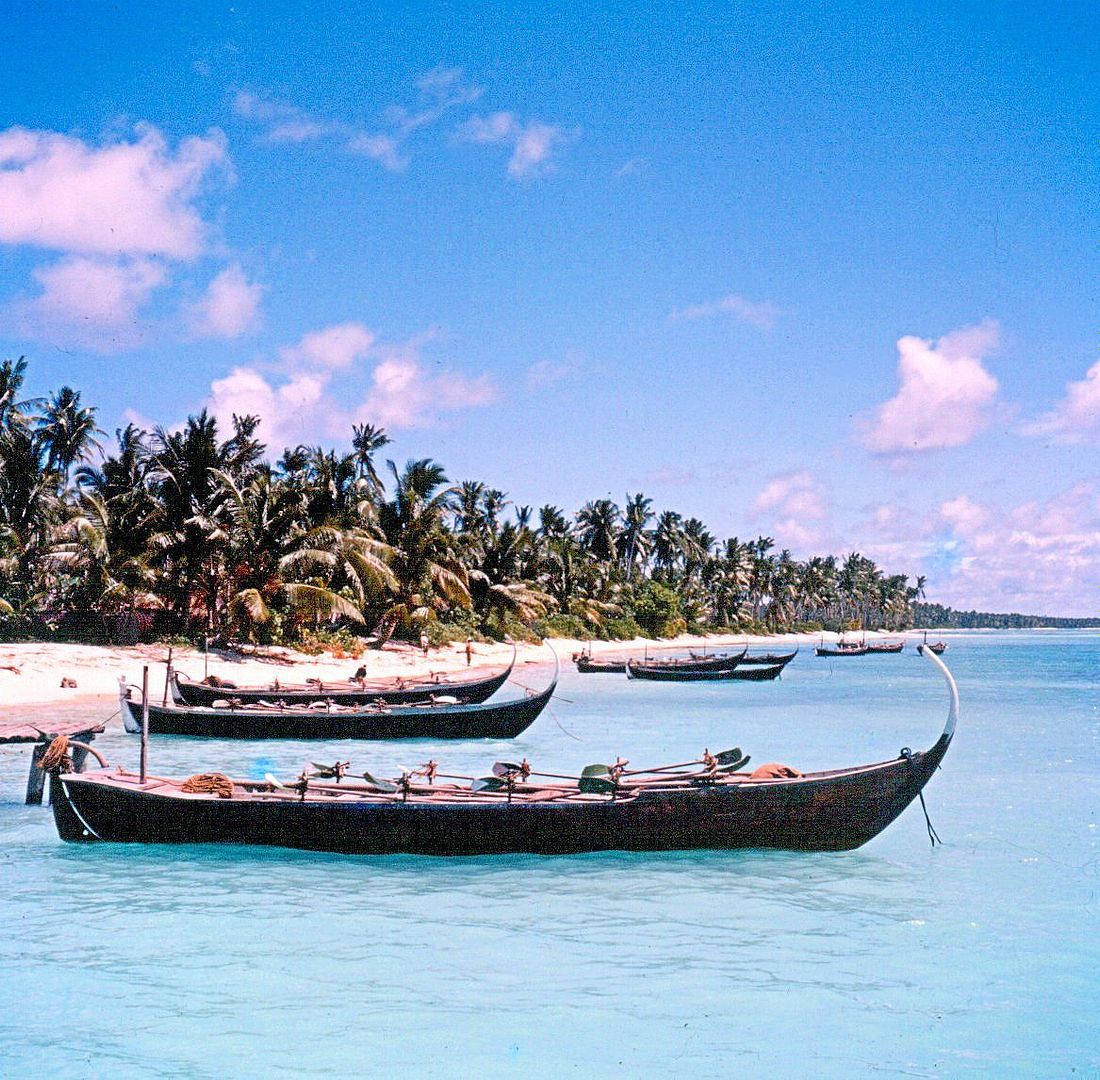
These Dhonis moored at Gan conveyed the islanders working at Gan to and from the further away islands such as Hittadu. They had masts with sails that could be raised that allowed them to make good progress in the fairly regular winds.
More to Come
Maldive Islanders
I took these photos mainly on the island of Fedu. Given that these photographs were taken 58-years ago in 1958 and the children shown were then aged about six to nine years old, if they are still around they’ll be aged about sixty plus-years old now.


When Britain obtained permission in 1956 to re-establish its wartime airfield on Gan, it was agreed that islanders living on Gan would be resettled on the nearest island, Fedu, with some of the islanders from Fedu moved to the next island, Maradu, where they formed a new village.
As a result the only Maldive islanders we RAF servicemen came into regular contact with in 1958 were the few who worked at Gan. On visits to other islands, mainly Fedu, families with kids would be seen, but that was about all. So my photos of islander’s families were taken on Fedu and Hittadu.



Kadjan (Palm Leaf) Weaving

Women using a pestle and mortar to crush Taro. Taro is a tuber that was cultivated extensively on Fedu up to WWII, but declined afterwards with growth confined to people’s gardens.


Coconut Collector

Caulking a Dhoni on Hittadu

With no ship's chandlers for hundreds of miles, the Islanders were adept at using local materials for essential boating artefacts. Here - chop down a tree, hollow out the trunk and bingo! one has an efficient bailer.

One of the more unusual vessels I photographed was this "Bigaloo". Used for longer inter-atoll journeys.

These Dhonis moored at Gan conveyed the islanders working at Gan to and from the further away islands such as Hittadu. They had masts with sails that could be raised that allowed them to make good progress in the fairly regular winds.
More to Come
Thread Starter
Continued - Part 12
The nearest island to Gan is Fedu which during WWII was connected to Gan by a causeway of concrete blocks laid with wooden beams and planks. These were used as a simple road to connect the two islands, but when we were there in 1958 the timber linking the concrete blocks had long since gone. Legend was that with no workable land-based wheeled vehicles left in the islands once the R.A.F. left at the end of the war; the islanders just removed the timber from the causeway for building purposes.
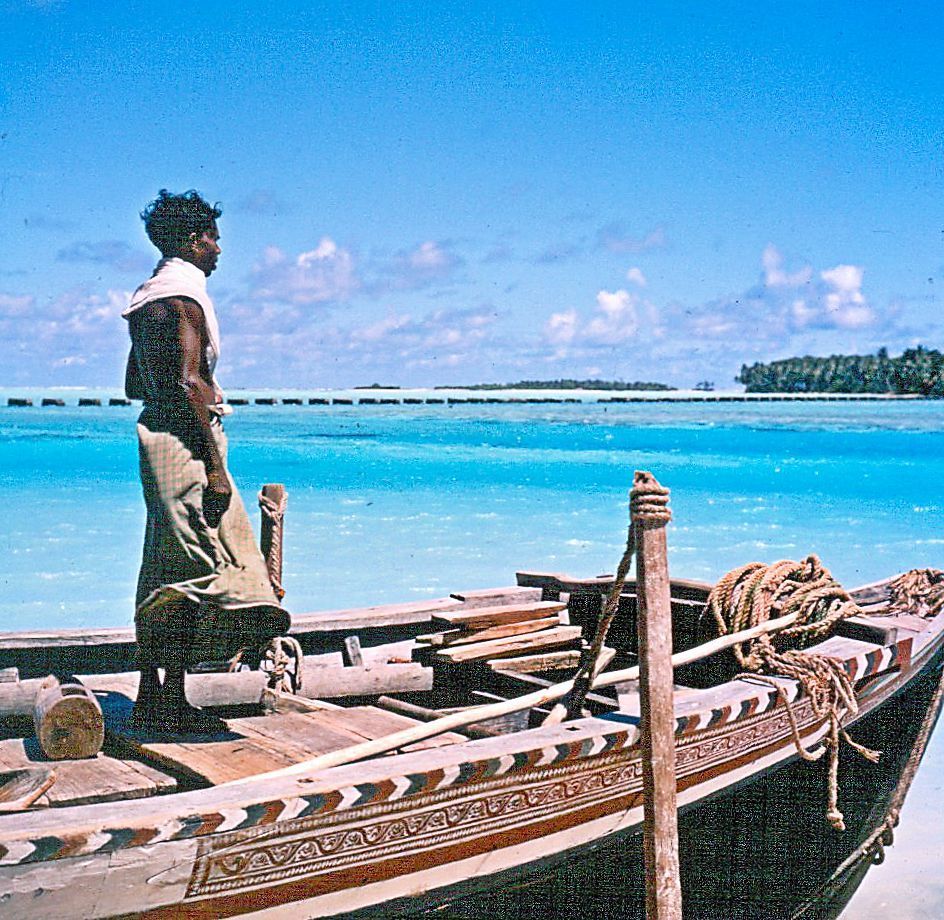
The WWII-built causeway linking Gan to Fedu can be seen in the background in my 1958 photo above.
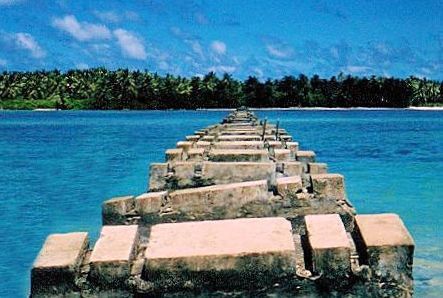
..and close-up showing where the timbers were originally laid.
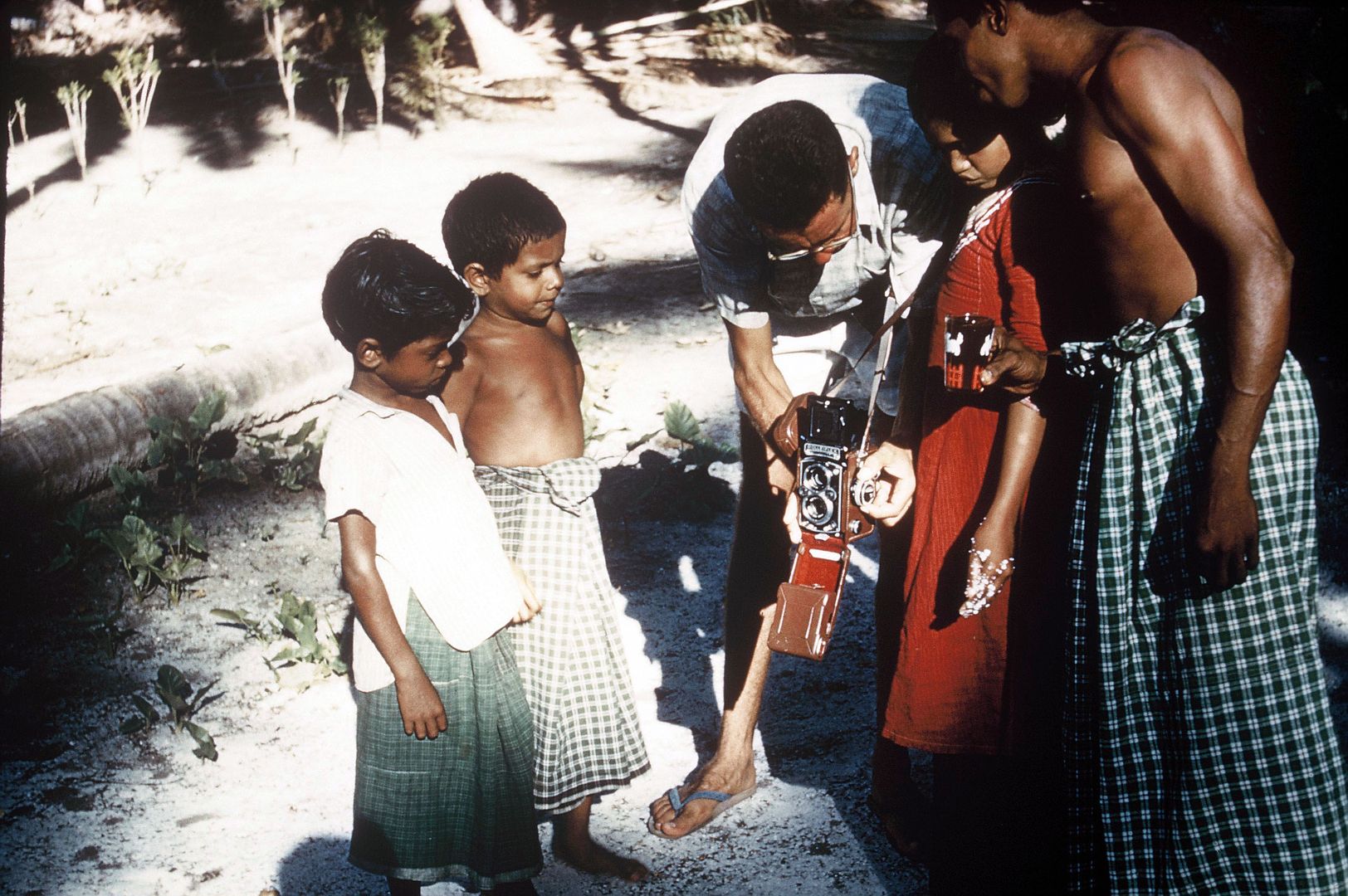
Photo taken on Fedu as I demonstrated my Rollieflex camera to the kids.
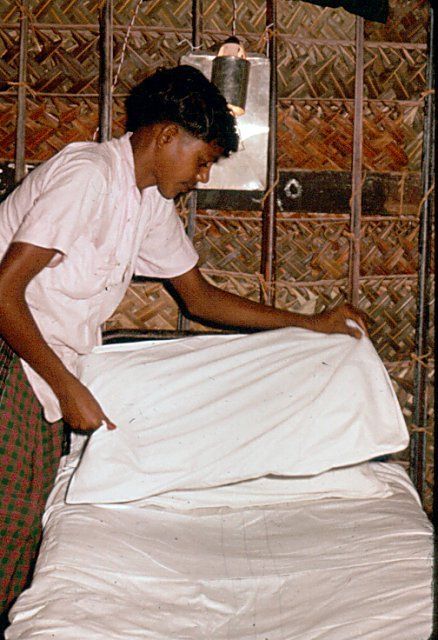
Hussein our billet boy. We paid him in cigarettes - about 20-cigarettes a week was the going rate ISTR. The walls of our billet consisted of woven palm leaves "Kadjan" - see the earlier photo of them being woven.
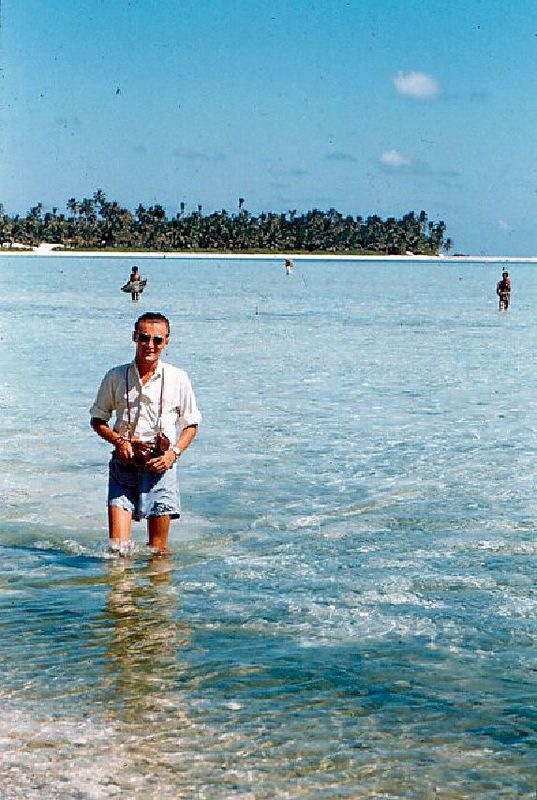
Wading across to Fedu. Local Islanders can be seen wading across too.
More to Come
WT
The nearest island to Gan is Fedu which during WWII was connected to Gan by a causeway of concrete blocks laid with wooden beams and planks. These were used as a simple road to connect the two islands, but when we were there in 1958 the timber linking the concrete blocks had long since gone. Legend was that with no workable land-based wheeled vehicles left in the islands once the R.A.F. left at the end of the war; the islanders just removed the timber from the causeway for building purposes.

The WWII-built causeway linking Gan to Fedu can be seen in the background in my 1958 photo above.

..and close-up showing where the timbers were originally laid.

Photo taken on Fedu as I demonstrated my Rollieflex camera to the kids.

Hussein our billet boy. We paid him in cigarettes - about 20-cigarettes a week was the going rate ISTR. The walls of our billet consisted of woven palm leaves "Kadjan" - see the earlier photo of them being woven.

Wading across to Fedu. Local Islanders can be seen wading across too.
More to Come
WT
Last edited by Warmtoast; 9th May 2016 at 16:04.
Join Date: Mar 2010
Location: Often in Jersey, but mainly in the past.
Age: 79
Posts: 7,812
Received 137 Likes
on
64 Posts
Lovely collection!
Don't forget the 'Gan Boats' - Palm wood (?) models of a typical Maldivian dhow which were also quite popular. Unfortunately although I got mine home with the rigging still intact central heating did for it in quick time. - Shackman
These Dhonis moored at Gan conveyed the islanders working at Gan to and from the further away islands such as Hittadu. They had masts with sails that could be raised that allowed them to make good progress in the fairly regular winds. - Warmtoast
Curiously enough, I was asked only the other day to set up the sail and rigging on a model dhoni which had been given to a friend by the butler of his accommodation on Meeru. Just glad that it wasn't rigged like the "Bigaloo"....
Very taken by your photographs, Warmtoast - no wonder you were asked back!
Jack
These Dhonis moored at Gan conveyed the islanders working at Gan to and from the further away islands such as Hittadu. They had masts with sails that could be raised that allowed them to make good progress in the fairly regular winds. - Warmtoast
Curiously enough, I was asked only the other day to set up the sail and rigging on a model dhoni which had been given to a friend by the butler of his accommodation on Meeru. Just glad that it wasn't rigged like the "Bigaloo"....
Very taken by your photographs, Warmtoast - no wonder you were asked back!

Jack
Mine was 'Bigaloo' style and looked very good before the rigging parted company. However, there were no more of these around the islands - the story was that there had been an 'uprising' (read protest) against the central government on Mali, and they in turn sent round a gunboat which destroyed all the larger boats in retaliation, leaving the islanders at the mercy of the government for all supplies. I might add that by then (1969) we were forbidden to visit the other islands, again by request of central government.
Thread Starter
RAF Gan 1958 - Continued - Part 13
Return to the UK
During my two-year Far East tour between October 1956 and November 1958 I’d been stationed at R.A.F. Changi (Singapore) - briefly, R.A.F. Negombo (Katunayake) Sri Lanka, R.A.F. China Bay (Trincomalee) Sri Lanka, R.A.F. Seletar (Singapore) and finally R.A.F. Gan.
I spent eleven months at Gan from January to November 1958. At the end of my tour I had the usual farewell party and departed Gan on the 12th of November 1958 to R.A.F. Katunayake near Colombo in Sri Lanka to join the Troopship Nevasa for my return to the UK.
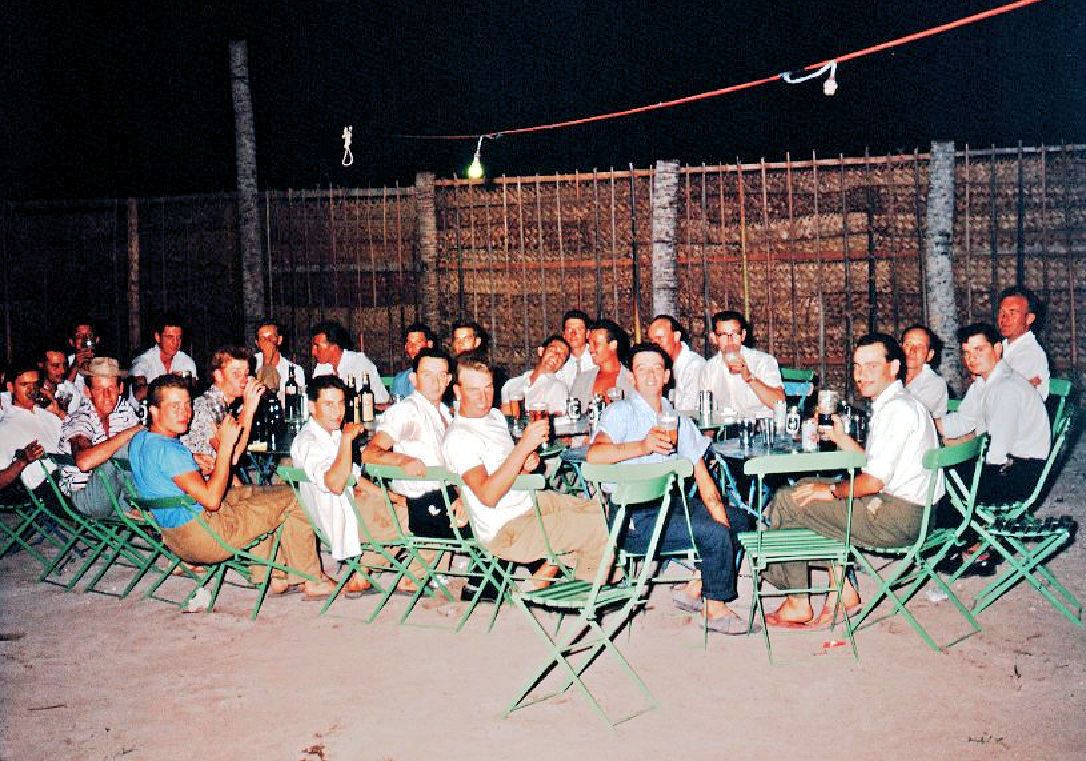
Farewell parties when someone returned home to the UK could be pretty lively events with plenty of drink being consumed as seen here at my November 1958 farewell party.
Tradition was that we all bought our own drinks, but at the end of the evening I was plied with many from friends and have only a hazy memory of the event, luckily I took this photo as a memento in the early stages of the party!
Return Journey — November/December 1958
Almost two years later to the day I'd arrived in the Far East, on the 12th of November 1958 to be exact, I departed from my final FEAF posting (RAF Gan in the Maldive Islands) having earlier during my Far East tour been stationed at Negombo, China Bay, Seletar and finally Gan, I flew from Gan to RAF Katunayake near Colombo in Sri Lanka to join the Nevasa at Colombo for my return to the UK.

Tour Ex - The best part of any posting - departing Gan.
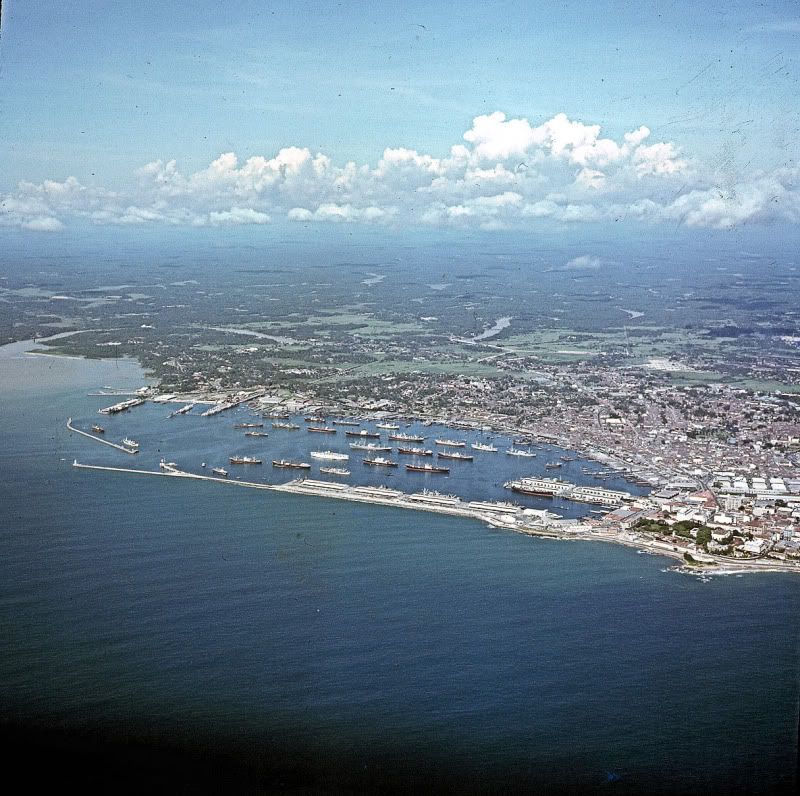
On the way from Gan to Katunayake we flew over Colombo harbour. The Nevasa, the large white vessel can be seen at anchor in the harbour.

The next day on the 13th of November 1958 I embarked on the Nevasa for the return voyage to the UK. Here Waiting in Colombo harbour for the ferry to the Nevasa that can be seen in the background.
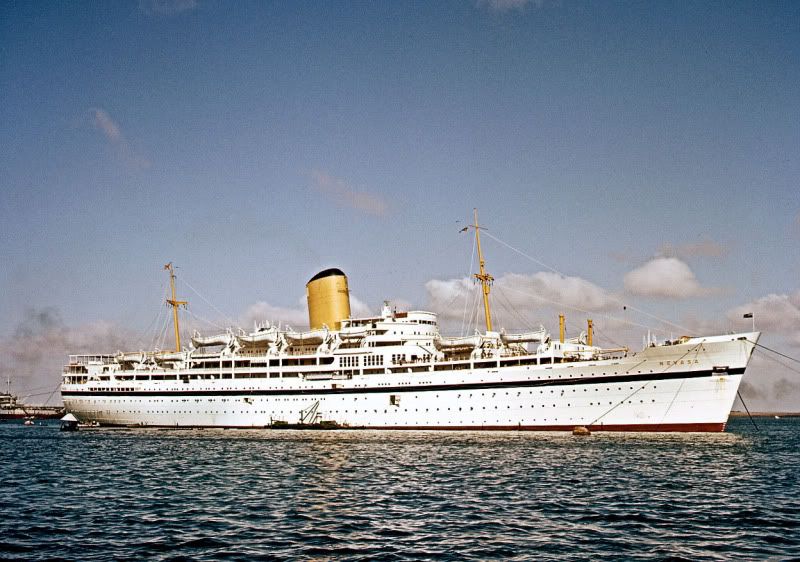
The Nevasa in all her glory
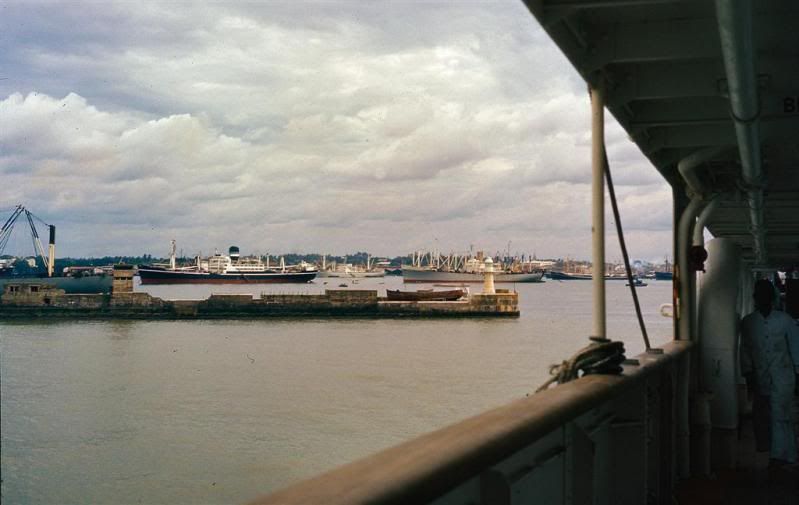
Departing Colombo Harbour en-route to our next stop - Aden.
We called at Aden and had a day ashore for duty-free shopping (I bought one of the newly introduced transistor radios very cheaply).
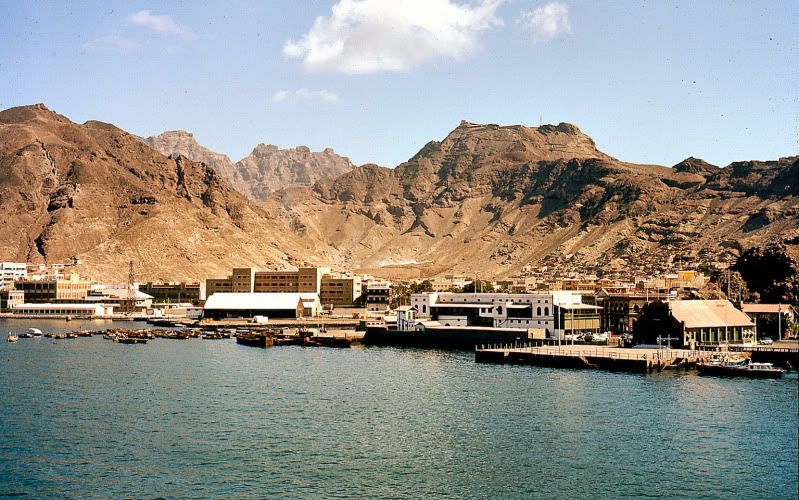
This view of Steamer Point shows the RN shore base at Aden (HMS Sheba) the low building on the extreme left alongside the waterfront with the Crescent Hotel immediately behind it.

Our passage along the Red Sea to Suez was easy and calm.
We sailed though the Suez Canal viewing the wrecks of ships sunk during the crisis two years earlier and we dropped anchor at Suez for a very short stop. We weren’t allowed ashore here but the bum-boats that swarmed around the ship did a brisk business in Egyptian trinkets and souvenirs. Following this short stop we were on our way again to our next stop in Gibraltar, our final stop on the way home, where we were allowed ashore again.
Some Memories
I have some memories of the trip home; the comfort level of the ship was improved in that the bunks were in tiers of three rather than the four that we endured on the way out. But the rest of the voyage was very similar to the journey out, PT on deck, team games and rifle shooting at balloons, more films in the evenings, most of which we’d all seen months earlier. The dining arrangements were similar to the journey out, but this time only with two sittings for meals rather than three. Thankfully we didn’t run out of beer on the way home, which was a relief.
Noteworthy was the sudden overnight change from the warmth of the Red Sea to the chill of the desert as we travelled north up the Red Sea. With the arrival of the cooler weather we were told to change from our tropical KD uniforms into standard UK uniforms. This caused a few problems as most of us hadn’t worn these for two years or so. Like many, my uniform had been sealed up in a waterproof bag shortly after my arrival in the Far East supposedly to stop it being affected by the high humidity, but in my case something had gone seriously wrong because when opened the uniform had gone mouldy – thankfully there was an Indian tailor among the ship’s crew who knew exactly how to deal with this problem (from experience perhaps?) and he passed it back to me, minus the mould, but stinking to high heaven — this musty odour remained with me for the rest of the voyage!
With my newly acquired transistor radio to play with as we travelled north up the Red Sea we searched the wave-bands for English broadcast stations and sure enough we started to receive the BBC relay station in the Middle East relaying the BBC World Service. Memorably the current hit, the Italian song ‘Volare’ which had featured in that year’s Eurovision Song contest was being played regularly. Whenever I hear it played today the catchy tune brings back memories of the Nevasa plying its way along the balmy Red Sea towards ‘Blighty’ in 1958.
Leaving Suez we entered the Mediterranean. The passage to our final stop at Gibraltar was notably rough. I was under the impression that the Mediterranean was a calm and blue sea, but in late November 1958 my assumptions were proved very wide of the mark — it was really rough!
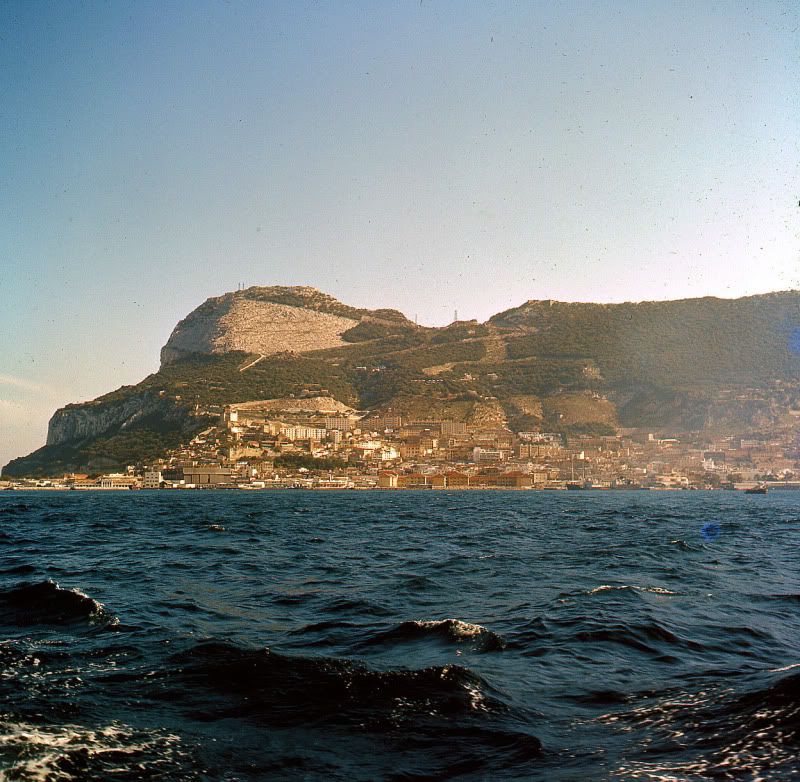
Approaching Gibraltar
Having docked at Gibraltar and been allowed ashore for more shopping, we departed for the UK.
The Nevasa docked at Southampton on the morning of the 1st of December 1958, and following the usual inspection by HM Customs in the customs shed at Southampton we joined the special steam-drawn boat train to London Waterloo only to find that there was no heating in the carriages; we had arrived in the middle of an early and particularly cold, cold spell and the steam heating of the carriages had frozen, leaving us with a two hour journey to Waterloo in a freezing cold train.
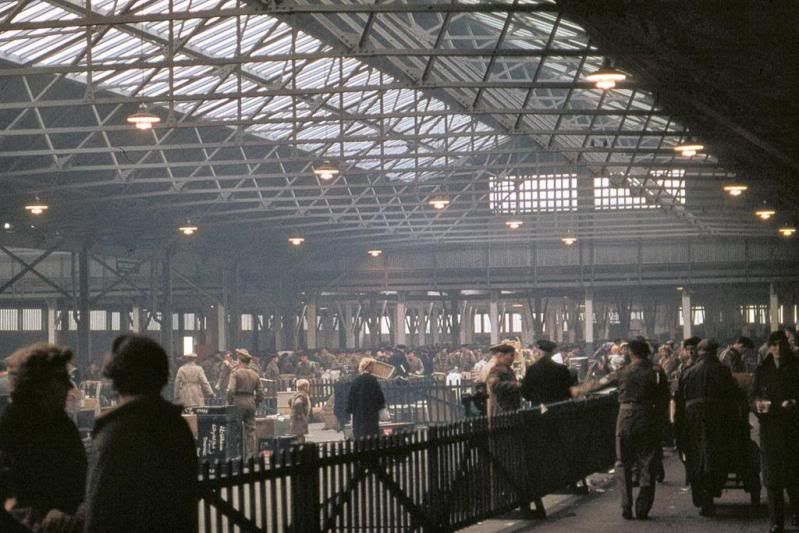
The Customs Shed at Southampton - December 1958
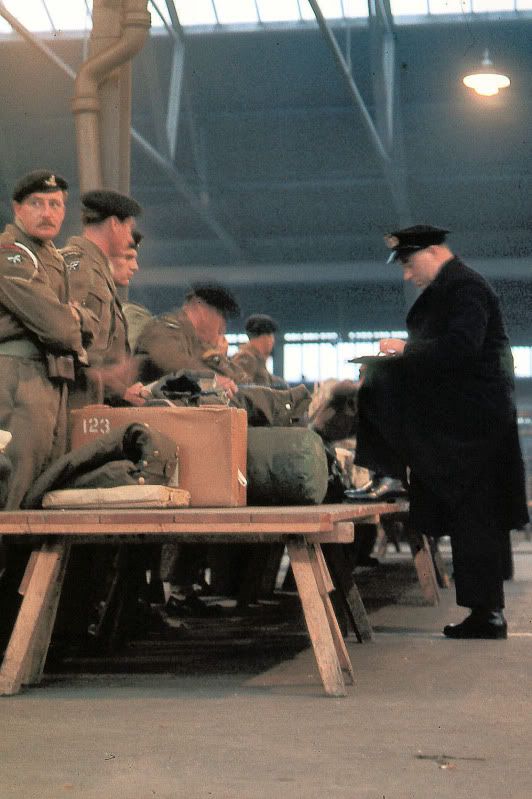
..and the Customs officers doing their business - "Anything to declare sir?"
Finally having reached London around mid-day I was met at Waterloo by my family and I had a short spell of leave before my next posting to RAF Abingdon near Oxford.
More to come
WT
Return to the UK
During my two-year Far East tour between October 1956 and November 1958 I’d been stationed at R.A.F. Changi (Singapore) - briefly, R.A.F. Negombo (Katunayake) Sri Lanka, R.A.F. China Bay (Trincomalee) Sri Lanka, R.A.F. Seletar (Singapore) and finally R.A.F. Gan.
I spent eleven months at Gan from January to November 1958. At the end of my tour I had the usual farewell party and departed Gan on the 12th of November 1958 to R.A.F. Katunayake near Colombo in Sri Lanka to join the Troopship Nevasa for my return to the UK.

Farewell parties when someone returned home to the UK could be pretty lively events with plenty of drink being consumed as seen here at my November 1958 farewell party.
Tradition was that we all bought our own drinks, but at the end of the evening I was plied with many from friends and have only a hazy memory of the event, luckily I took this photo as a memento in the early stages of the party!
Return Journey — November/December 1958
Almost two years later to the day I'd arrived in the Far East, on the 12th of November 1958 to be exact, I departed from my final FEAF posting (RAF Gan in the Maldive Islands) having earlier during my Far East tour been stationed at Negombo, China Bay, Seletar and finally Gan, I flew from Gan to RAF Katunayake near Colombo in Sri Lanka to join the Nevasa at Colombo for my return to the UK.

Tour Ex - The best part of any posting - departing Gan.

On the way from Gan to Katunayake we flew over Colombo harbour. The Nevasa, the large white vessel can be seen at anchor in the harbour.

The next day on the 13th of November 1958 I embarked on the Nevasa for the return voyage to the UK. Here Waiting in Colombo harbour for the ferry to the Nevasa that can be seen in the background.

The Nevasa in all her glory

Departing Colombo Harbour en-route to our next stop - Aden.
We called at Aden and had a day ashore for duty-free shopping (I bought one of the newly introduced transistor radios very cheaply).

This view of Steamer Point shows the RN shore base at Aden (HMS Sheba) the low building on the extreme left alongside the waterfront with the Crescent Hotel immediately behind it.

Our passage along the Red Sea to Suez was easy and calm.
We sailed though the Suez Canal viewing the wrecks of ships sunk during the crisis two years earlier and we dropped anchor at Suez for a very short stop. We weren’t allowed ashore here but the bum-boats that swarmed around the ship did a brisk business in Egyptian trinkets and souvenirs. Following this short stop we were on our way again to our next stop in Gibraltar, our final stop on the way home, where we were allowed ashore again.
Some Memories
I have some memories of the trip home; the comfort level of the ship was improved in that the bunks were in tiers of three rather than the four that we endured on the way out. But the rest of the voyage was very similar to the journey out, PT on deck, team games and rifle shooting at balloons, more films in the evenings, most of which we’d all seen months earlier. The dining arrangements were similar to the journey out, but this time only with two sittings for meals rather than three. Thankfully we didn’t run out of beer on the way home, which was a relief.
Noteworthy was the sudden overnight change from the warmth of the Red Sea to the chill of the desert as we travelled north up the Red Sea. With the arrival of the cooler weather we were told to change from our tropical KD uniforms into standard UK uniforms. This caused a few problems as most of us hadn’t worn these for two years or so. Like many, my uniform had been sealed up in a waterproof bag shortly after my arrival in the Far East supposedly to stop it being affected by the high humidity, but in my case something had gone seriously wrong because when opened the uniform had gone mouldy – thankfully there was an Indian tailor among the ship’s crew who knew exactly how to deal with this problem (from experience perhaps?) and he passed it back to me, minus the mould, but stinking to high heaven — this musty odour remained with me for the rest of the voyage!
With my newly acquired transistor radio to play with as we travelled north up the Red Sea we searched the wave-bands for English broadcast stations and sure enough we started to receive the BBC relay station in the Middle East relaying the BBC World Service. Memorably the current hit, the Italian song ‘Volare’ which had featured in that year’s Eurovision Song contest was being played regularly. Whenever I hear it played today the catchy tune brings back memories of the Nevasa plying its way along the balmy Red Sea towards ‘Blighty’ in 1958.
Leaving Suez we entered the Mediterranean. The passage to our final stop at Gibraltar was notably rough. I was under the impression that the Mediterranean was a calm and blue sea, but in late November 1958 my assumptions were proved very wide of the mark — it was really rough!

Approaching Gibraltar
Having docked at Gibraltar and been allowed ashore for more shopping, we departed for the UK.
The Nevasa docked at Southampton on the morning of the 1st of December 1958, and following the usual inspection by HM Customs in the customs shed at Southampton we joined the special steam-drawn boat train to London Waterloo only to find that there was no heating in the carriages; we had arrived in the middle of an early and particularly cold, cold spell and the steam heating of the carriages had frozen, leaving us with a two hour journey to Waterloo in a freezing cold train.

The Customs Shed at Southampton - December 1958

..and the Customs officers doing their business - "Anything to declare sir?"
Finally having reached London around mid-day I was met at Waterloo by my family and I had a short spell of leave before my next posting to RAF Abingdon near Oxford.
More to come
WT
Last edited by Warmtoast; 11th May 2016 at 21:02.
Thread Starter
RAF Gan 1958 - Continued - Part 14
Back Home — 1959 Medical Scare — Elephantiasis
Following my arrival home in December 1958, early the following year (1959) whilst stationed at R.A.F. Abingdon I was contacted by the station medical centre and told that I had to attend the R.A.F. Hospital at Halton for a medical examination; no reason was given and I was provided with a letter for me to report to the Institute of Pathology and Tropical Medicine at Halton. As it specialised in tropical medicine I suspected it was something to do with my recent service in the Far East, but otherwise I was puzzled by the need for the appointment.
Accordingly I attended the hospital, had a blood sample taken and was given a general medical examination. I was told I would be summoned back for further examination if any abnormalities were found — in the event about a month later I was sent for by the MO at R.A.F. Abingdon who told me everything was all clear and that I was not infected, only then was I told that there had been a scare that a case of Lymphatic Filariasis (Elephantiasis) had been diagnosed in a servicemen who’d been stationed at Gan with the result that I and others who’d served at Gan had had to be screened for possible infection.
Until then I’d no real knowledge about the disease, although I seem to recall that the walls of the waiting area at the Institute of Pathology and Tropical Medicine at Halton Hospital were adorned with gory photos of sufferers who exhibited the typical symptoms of the disease with gross deformities of the limbs and in men hugely enlarged Genitals (mainly the scrotum).
It is only relatively recently with the potential for research via the internet that I found that the R.A.F. had cause for concern about the health of airmen returning from Gan as a 1950’s United Nations (WHO) study based on a survey of the southern atolls of the Maldives, including Addu Atoll where Gan is located, showed that Filariasis (Elephantiasis) was endemic in all the villages (islands) of Addu Atoll with a filarial infection rate in the population of 14.1%.
United Nations (WHO) Addu Atoll Study
The introduction to the UN (WHO) research paper states:
“Filariasis is an important public-health problem in the Maldive Islands. The World Health Organization received a request through the Government of the United Kingdom of Great Britain and Northern Ireland for technical assistance in the eradication of the disease. To comply with this request, the decision was taken by the WHO to appoint a consultant on a short-term assignment to study the problem and to submit recommendations for the control of the disease. The author was appointed as the WHO Filariasis Consultant and, with the assistance of Dr. M. I. Mathew and Mr. M. A. U. Menon, carried out investigations during January to March 1951 on Filariasis in the Maldives.”
Description of the Disease (from WHO Website)
“Lymphatic filariasis is infection with the filarial worms, Wuchereria bancrofti, Brugia malayi or B. timori. These parasites are transmitted to humans through the bite of an infected mosquito and develop into adult worms in the lymphatic vessels, causing severe damage and swelling (lymphoedema). Elephantiasis, a painful disfiguring swelling of the legs and genital organs – is a classic sign of late-stage disease.”
The photograph below is courtesy GlaxoSmithKline who make the drug albendazole an anti-parasitic drug that plays a vital role in helping to prevent the transmission of the disease.
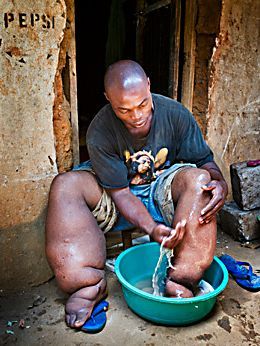
More to come - with photos of my 2014 visit
WT
Back Home — 1959 Medical Scare — Elephantiasis
Following my arrival home in December 1958, early the following year (1959) whilst stationed at R.A.F. Abingdon I was contacted by the station medical centre and told that I had to attend the R.A.F. Hospital at Halton for a medical examination; no reason was given and I was provided with a letter for me to report to the Institute of Pathology and Tropical Medicine at Halton. As it specialised in tropical medicine I suspected it was something to do with my recent service in the Far East, but otherwise I was puzzled by the need for the appointment.
Accordingly I attended the hospital, had a blood sample taken and was given a general medical examination. I was told I would be summoned back for further examination if any abnormalities were found — in the event about a month later I was sent for by the MO at R.A.F. Abingdon who told me everything was all clear and that I was not infected, only then was I told that there had been a scare that a case of Lymphatic Filariasis (Elephantiasis) had been diagnosed in a servicemen who’d been stationed at Gan with the result that I and others who’d served at Gan had had to be screened for possible infection.
Until then I’d no real knowledge about the disease, although I seem to recall that the walls of the waiting area at the Institute of Pathology and Tropical Medicine at Halton Hospital were adorned with gory photos of sufferers who exhibited the typical symptoms of the disease with gross deformities of the limbs and in men hugely enlarged Genitals (mainly the scrotum).
It is only relatively recently with the potential for research via the internet that I found that the R.A.F. had cause for concern about the health of airmen returning from Gan as a 1950’s United Nations (WHO) study based on a survey of the southern atolls of the Maldives, including Addu Atoll where Gan is located, showed that Filariasis (Elephantiasis) was endemic in all the villages (islands) of Addu Atoll with a filarial infection rate in the population of 14.1%.
United Nations (WHO) Addu Atoll Study
The introduction to the UN (WHO) research paper states:
“Filariasis is an important public-health problem in the Maldive Islands. The World Health Organization received a request through the Government of the United Kingdom of Great Britain and Northern Ireland for technical assistance in the eradication of the disease. To comply with this request, the decision was taken by the WHO to appoint a consultant on a short-term assignment to study the problem and to submit recommendations for the control of the disease. The author was appointed as the WHO Filariasis Consultant and, with the assistance of Dr. M. I. Mathew and Mr. M. A. U. Menon, carried out investigations during January to March 1951 on Filariasis in the Maldives.”
Description of the Disease (from WHO Website)
“Lymphatic filariasis is infection with the filarial worms, Wuchereria bancrofti, Brugia malayi or B. timori. These parasites are transmitted to humans through the bite of an infected mosquito and develop into adult worms in the lymphatic vessels, causing severe damage and swelling (lymphoedema). Elephantiasis, a painful disfiguring swelling of the legs and genital organs – is a classic sign of late-stage disease.”
The photograph below is courtesy GlaxoSmithKline who make the drug albendazole an anti-parasitic drug that plays a vital role in helping to prevent the transmission of the disease.

More to come - with photos of my 2014 visit
WT
Last edited by Warmtoast; 13th May 2016 at 23:08.
Join Date: Feb 2008
Location: East Sussex UK
Age: 66
Posts: 6,995
Likes: 0
Received 1 Like
on
1 Post
Warmtoast ...
What a simply fantastic historic record of your service ... the pictures bring everything to life.
Thank you ... and looking forward to your next instalment
What a simply fantastic historic record of your service ... the pictures bring everything to life.
Thank you ... and looking forward to your next instalment

Guest
Posts: n/a
Warmtoast,
What a wonderful file of photographs - and a wonderful store of memories of your past youth !
Wish I'd got something like that. But in war zones (I think), even still photographs were forbidden (and even more "home cinema" stuff) for obvious security reasons (they might fall into the hands of the enemy, and skilled photo interpreters can find all sorts of useful detail from the seemingly most innocent of "snaps").
Gruesome picture of elephantiasis (rings bell, see my p.130 #2588 on "Pilot's Brevet").
(Customs at Southamptom): Get the shoes on that Preventive Officer - there's 'Bull' for you - a credit to the Waterguard !
(Customs Shed): We were luckier - ours shrank from us in horror at Liverpool [as being potential carriers of a new and untreatable smallpox] and waved us through without examination).
Thank you, WT - them were the days, weren't they ?
Danny.
What a wonderful file of photographs - and a wonderful store of memories of your past youth !
Wish I'd got something like that. But in war zones (I think), even still photographs were forbidden (and even more "home cinema" stuff) for obvious security reasons (they might fall into the hands of the enemy, and skilled photo interpreters can find all sorts of useful detail from the seemingly most innocent of "snaps").
Gruesome picture of elephantiasis (rings bell, see my p.130 #2588 on "Pilot's Brevet").
(Customs at Southamptom): Get the shoes on that Preventive Officer - there's 'Bull' for you - a credit to the Waterguard !
(Customs Shed): We were luckier - ours shrank from us in horror at Liverpool [as being potential carriers of a new and untreatable smallpox] and waved us through without examination).
Thank you, WT - them were the days, weren't they ?
Danny.
Thread Starter
Thanks Gents for the compliments - much appreciated!
As a PS to the bit about the trip home, although the Nevasa looks splendid in my photographs, it wasn't all sweetness and light as can be seen in my photo of the sleeping arrangements in the troop decks.
Three tiers high - but on the way out in 1956 after delays to the trooping schedules because of the Suez crises, an additional tier of bunks were squeezed in, making them four high rather than the three shown on the way home - below.
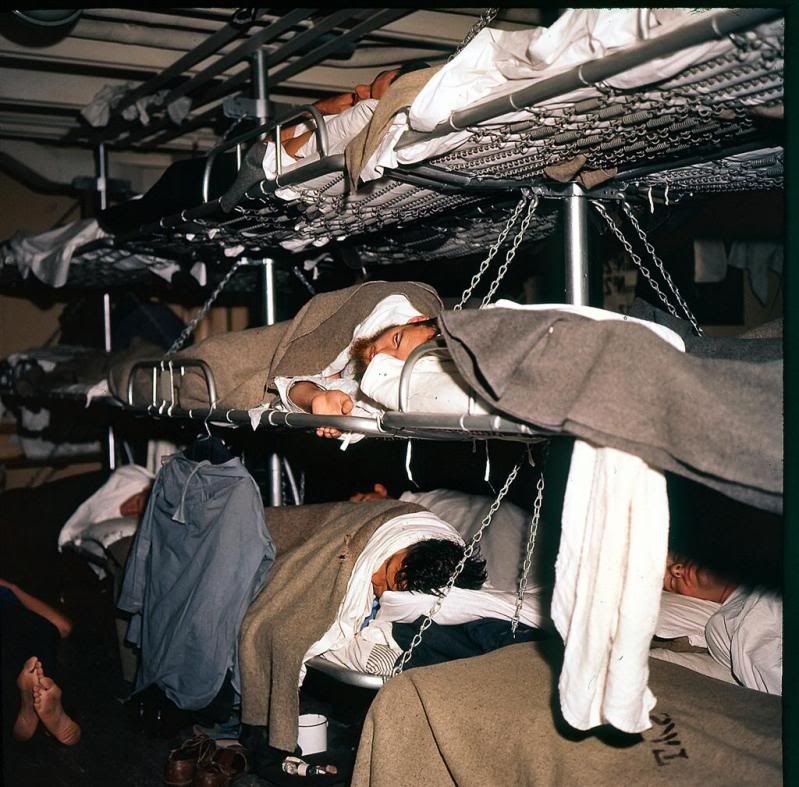
WT
As a PS to the bit about the trip home, although the Nevasa looks splendid in my photographs, it wasn't all sweetness and light as can be seen in my photo of the sleeping arrangements in the troop decks.
Three tiers high - but on the way out in 1956 after delays to the trooping schedules because of the Suez crises, an additional tier of bunks were squeezed in, making them four high rather than the three shown on the way home - below.

WT
Join Date: Mar 2010
Location: Often in Jersey, but mainly in the past.
Age: 79
Posts: 7,812
Received 137 Likes
on
64 Posts
Warmtoast .. an ongoing, fabulous, memoir. I wish now that I had bought a camera back in the 60s in Singapore, but I spent all my money on car, beer and women ... and was still paying off my UK tailor's bill having spent my initial Officers' Uniform Allowance on a car 3 years earlier*! Come to think of it, I still don't have a proper camera, just a pocket Lumix 
* In fact, I was for a while a 2-car a/plt off at Shawbury, and used to rent out the lesser one for 10/0 a night - "Make your own arrangements with the Police if you get stopped"

* In fact, I was for a while a 2-car a/plt off at Shawbury, and used to rent out the lesser one for 10/0 a night - "Make your own arrangements with the Police if you get stopped"




